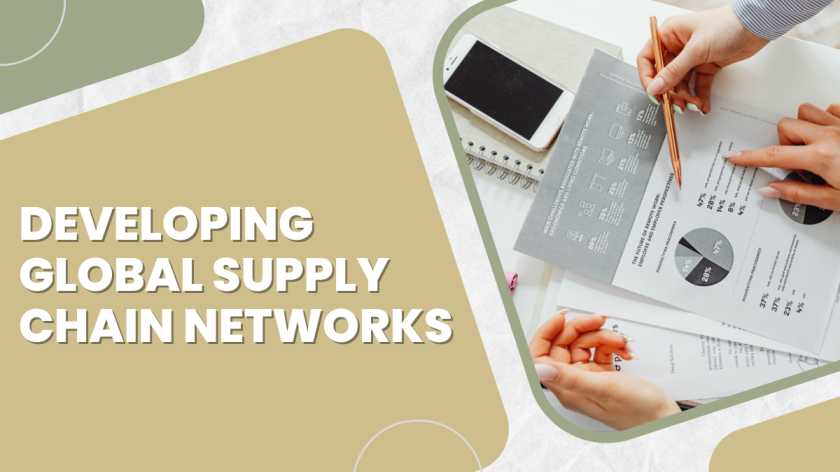Last updated on July 16th, 2024 at 01:11 pm
In today’s global economy, businesses must think and act globally, utilising global supply chain networks. These networks serve as a lifeline for businesses, providing integration into the global market and relying on international supply chains for inputs. It goes beyond shipping products overseas and reaches customers worldwide. A well-organised global supply chain can benefit businesses by making things more efficient, cutting costs, and focusing on the ultimate result: customer satisfaction.
The growing importance of global supply chains has also made way for exciting opportunities for a career in supply chain management. People working in this field have a crucial role in managing complex networks and ensuring the smooth movement of products worldwide.
So, if you’re interested in this career path, taking a comprehensive supply chain management course can be highly beneficial for you.
Planning and Designing Global Supply Chain Networks
When planning and designing global supply chain networks, it’s crucial first to understand your specific needs. These needs include expanding market reach, streamlining operations, or leveraging cost advantages. Gather detailed insights on business objectives, customer profiles, and product specifications to establish the foundational needs of your future global supply chain.
The next pivotal step is choosing the right strategy. This requires thoroughly analysing market trends, competitor strategies, and risk assessments. Your chosen strategy should align with your business goals, such as market penetration, diversification, or product development. Additionally, the strategy must account for the target markets’ logistical complexities, regulatory environments, and cultural nuances.
Finally, an adaptable supply chain network design is a must in an ever-changing global market. This design should accommodate fluctuations in demand, supply, and external factors while also incorporating advanced technologies and analytics to enhance visibility, control, and adaptability. By doing so, your global supply chain can remain resilient in the face of constant change.
Building and Implementing Global Supply Chain Networks
Building and implementing a robust global supply chain network involves a systematic series of steps. Here are the crucial steps to follow:
Identify Key Partners and Suppliers: To establish a global supply chain, start by identifying dependable partners and suppliers capable of consistently delivering quality goods and services.
Develop a Strategic Plan: Create a strategic plan for your supply chain. This should outline your goals, strategies for reaching them, and metrics for measuring success.
Implement Technology: Leverage modern technology to streamline processes, improve efficiency, and foster real-time communication among network participants.
Establish Logistics and Distribution Networks: Develop efficient logistics and distribution channels to ensure timely delivery of goods and services.
Implement Risk Management Strategies: Identify potential risks and develop contingency plans to manage them. This might involve diversifying suppliers or creating redundancy in your supply chain.
Continuous Improvement and Optimisation: Regularly assess the performance of your supply chain and make necessary adjustments to improve efficiency and effectiveness.
Implementing the Designed Supply Chain Network
The following are the steps you can follow while implementing the structured supply chain network:
Establish Clear Communication Channels: To successfully implement a global supply chain network, establish clear and effective communication channels. All stakeholders must understand their roles, responsibilities, and the project’s goals. Maintain clear, open, and consistent communication for a smooth and efficient project.
Launch Procurement and Logistics Operations: After establishing communication channels, the next step is to launch procurement and logistics operations. This includes setting up warehouses, establishing transportation links, and initiating procurement from suppliers. Ensuring efficiency and organisation in these operations builds a solid foundation for your supply chain network.
Monitor and Continually Improve Supply Chain Operations: After launching your operations, it’s important not to rest on your laurels. Instead, you need to monitor your operations and continually strive for improvement. You can achieve this by tracking key performance indicators (KPIs), studying market trends, and making necessary adjustments to enhance efficiency and reduce costs.
Consistent Review and Improvement: Finally, consistent review and improvement are vital to maintaining the relevance and effectiveness of your designed network. This involves proactive analysis of your operations, seeking opportunities for improvement, and implementing changes where necessary. By keeping the pulse on your operations and market trends, you can ensure your supply chain network remains strong and competitive.
Managing Global Supply Chain Networks
Technology plays a crucial role in transforming and streamlining processes in global supply chain management. Advanced software solutions, artificial intelligence, and automation have bridged global gaps between producers, suppliers, and consumers, enabling real-time tracking, accurate forecasting, and efficient resource allocation. These technological advancements reduce costs, enhance productivity, and improve overall efficiency.
However, managing global supply chains comes with its challenges. Complexities arise from factors such as differing regulatory frameworks, cultural disparities, and logistical hurdles. To overcome these challenges, organisations should take a proactive approach. This includes integrating adaptive technologies, fostering strong relationships with local partners, and implementing risk management strategies to address disruptions and ensure operational flow swiftly.
To prioritise smooth operations and minimise disruptions, businesses employ several strategies. These include using predictive analytics powered by machine learning algorithms to identify potential issues proactively. Leaders can then take corrective measures. Furthermore, robust contingency plans and an Agile supply chain model ensure business continuity, even in unforeseen circumstances.
Conclusion
As businesses become more global and interconnected, supply chain roles will only increase in importance. Navigating this complex landscape requires a solid foundation of knowledge. This is where taking a supply chain management course can be really useful.
Considering a career in supply chain management?
The Professional Certification in Supply Chain Management & Analytics from Imarticus Learning, in collaboration with IIT Roorkee, equips you with the necessary skills to ensure efficient supply chain operations in a constantly evolving global market. This comprehensive supply chain course includes a campus immersion programme and provides insights into the modern era of supply chain management.
That said, don’t just leap in without preparation. Get yourself enrolled in a supply chain course that will provide you with the necessary knowledge to succeed.
Get in touch!

